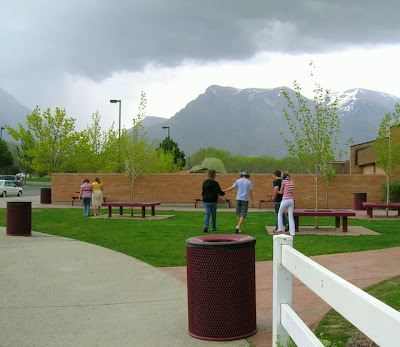The tutors were split into two groups - sighted guides and deafblind individuals. To make the students deafblind, they each put in foam earplugs, donned an eye band and eye mask and topped it off with headphones. The sighted giudes were asked not to speak during the simulation to aid in the deafness of the experience. While it isn't possible to make them completely deaf and blind - they were able to get a taste of what it feels like. You might want to try this sometime - my kids have all done it. Try eating a meal like this or getting ready for bed, it's not as easy as you might think.

For those of you who don't know, my son has significant hearing and vision disabilities, and since most of these students work with him we decided to show them a little bit of what it's like for him. They were given tasks to accomplish that they had never seen or felt before. Minimal assistance and no instructions were given to them.

They had to rely on their hands (and other senses) to figure out what to do, and just when they were finished their work was taken apart for them to do over or else put away. This sort of thing can happen a lot to people with disabilities. People (parents included) who work with these individuals some times get wrapped up in the goals they are supposed to be accomplishing, and the personal achievements and relationships can be lost or put on the back burner.
I asked the kids how many of them used to play Legos, and then followed up with asking if their creations were ever destroyed by a sibling or when they were in the middle of a project - did their mom tell them to put it away. I wanted them to realize that it's a universal feeling to want to share what you've done with others.

Some of the students were led around the school and some were taken outside (and rained on a bit). They were also left alone for about 30 seconds - 1 minute. Some of the deafblind students did not know why they were left alone and began feeling around 'looking' for their sighted guide. At one point, two blindfolded students found each other and each thought the other was a sighted person. Then one of them grabbed the hand of the other and began walking. It took them a few seconds to realize that neither one of them could guide the other (I'm sure there's a parable/metaphor in there somewhere). It was intriguing to watch.

They were given food to eat, some of it was unceremoniously shoved into their mouth and some was given to them to explore before eating. Random loud noises sounded in their ears, their arms and faces were brushed with feathers or baby wipes without and warning.

All in all, it was a very 'eye-opening' experience for those involved (my appreciation to the staff at the school for making it possible). It's a bit tricky to debrief the junior high crowd - they are not the most communicative bunch, but all of them acknowledged that it was frustrating to have things happen to them without any way of knowing what was coming next. We talked about communication and sign language.
I know that most of them felt a real impact and new appreciation for those with sensory disabilities.

